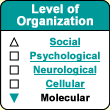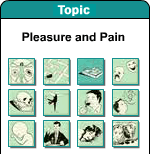| |

 |
 |
 |
Nearly 15% of all men and 30% of all women admit
to a craving for chocolate.
Over 300 substances have
been identified in chocolate. Some of these, including caffeine and theobromine
(another, less powerful stimulant) could actually cause dependency effects. But
the amounts of these substances in chocolate are too small to really have any
effect.
The same goes for phenylethylamine, a substance related to a
family of stimulants called amphetamines. For example, chocolate contains less
phenylethylamine than goat cheese.
Anandamide, a neurotransmitter produced
naturally by the brain, has also been isolated in chocolate. The neural receptors
for anandamide are the same ones to which THC, the main active ingredient in cannabis,
binds. The anandamide in chocolate might therefore contribute to the feeling of
well-being reported by “chocoholics” (though you would have to eat
well over 30 kilos of chocolate to experience effects comparable to one dose of
cannabis!).
Be that as it may, many scientists agree that dependency
on chocolate could simply be due to its taste, which causes a sensation of intense
pleasure that people want to repeat. | | |
| HOW DRUGS AFFECT NEUROTRANSMITTERS | | Dopamine
appeared very early in the course of evolution and is involved in many functions
that are essential for survival of the organism, such as motricity, attentiveness,
motivation, learning,
and memorization. But most of all, dopamine is a key element in identifying
natural rewards for the organism. These natural stimuli such as food and water
cause individuals to engage in approach
behaviours. Dopamine is also involved in unconscious memorization of signs
associated with these rewards.
It has now been established that all
substances that trigger dependencies in human beings increase the release of a
neuromediator, dopamine, in a specific area of the brain: the
nucleus accumbens.  But
not all drugs increase dopamine levels in the brain in the same way.
- Some substances imitate natural neuromediators
and take their place on their receptors. Morphine, for example, binds to the receptors
for endorphin (a natural "morphine" produced by the brain), while nicotine
binds to the receptors for acetylcholine.
- Other
substances increase the secretion of natural neuromediators.
Cocaine, for example, mainly increases the amount of dopamine in the synapses,
while ecstasy mainly increases the amount of serotonin.
-
Still other substances block a natural neuromediator. Alcohol,
for example, blocks the NMDA receptors.
Click
on the names of each of the following drugs to read about how they work and what
effects they have. Alcohol
----- Opiates
(heroin, morphine, etc.) ----- Cocaïne
----- Nicotine
Caffeine
----- Amphetamines
----- Cannabis
----- Ecstasy
----- Benzodiazepines
Ecstasy Ecstasy
(MDMA) is a synthetic drug. It acts simultaneously as a stimulant and a hallucinogen
because of its molecular structure, which is similar to that of both amphetamines
and LSD. Like amphetamines and cocaine, ecstasy blocks the reuptake pumps for
certain neurotransmitters, thus increasing their levels in the synaptic gap and
their effect on the post-synaptic neurons’ receptors.
While ecstasy
also potentiates the effects of norepinephrine and dopamine, it is distinguished
from other psychostimulants by its strong affinity for serotonin transporters.
The initial effect of ecstasy is thus an increased release of serotonin by the
serotonergic neurons. The individual may then experience increased energy, euphoria,
and the suppression of certain inhibitions in relating to other people.
A few hours later, there is a decrease in serotonin levels, amplified by the reduced
activity of tryptophane hydroxylase, the enzyme responsible for synthesizing serotonin.
This decrease can last much longer than the initial increase. Once again, an artificial
increase in the level of a neurotransmitter exercises negative feedback on the
enzyme that manufactures it. As a result, when intake of the drug ceases, the
excess turns into a shortage.
Like all psychoactive drugs that produce
a sensation of pleasure, ecstasy also increases the release of dopamine into the
reward circuit. In addition, the extra serotonin produced by ecstasy leads indirectly
to excitement of the dopaminergic neurons by the serotonergic neurons that connect
to them.
The toxicity of ecstasy for humans has not been clearly established,
but animal studies have shown that chronic high doses of MDMA lead to selective
destruction of the terminal buttons of the serotonergic neurons. | | |
| |




